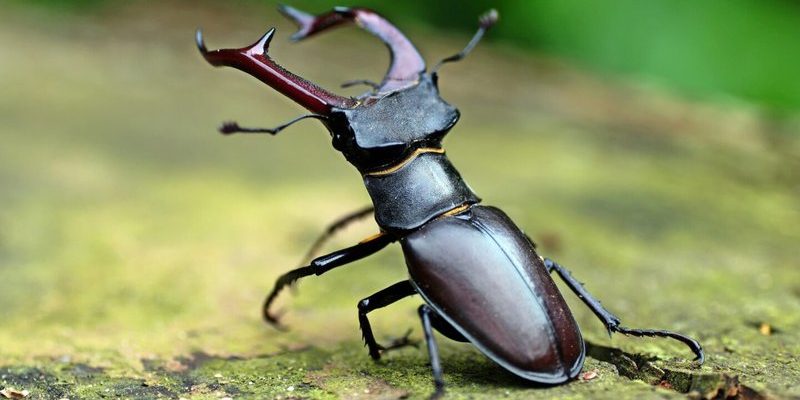
Stag beetles belong to the family Lucanidae and are known for their large size and unique antler-like jaws. Their appearance might remind you of a tiny dinosaur, making them both impressive and a bit scary. But before you let fear take over, it’s important to understand their behavior and whether they pose any real threat. After all, not all bugs that look fierce are out to get you!
What Are Stag Beetles?
Stag beetles can be found in various parts of the world, with many species residing in Europe, Asia, and North America. They typically thrive in wooded areas where they can find plenty of decaying wood to munch on, as larvae. These beetles are most recognizable for their distinctive horns, which male stag beetles use during mating battles. Think of it as nature’s version of a wrestling match, where the strongest contenders show off their impressive features.
Adult stag beetles can range in size from about 1 to 5 inches long. Their bodies are often black, brown, or even metallic, with most species exhibiting a glossy finish. The males are usually larger than females, equipped with massive mandibles that can make them look quite intimidating. However, it’s important to note that these impressive jaws are primarily used for fighting other males and attracting females, not for attacking humans.
Are Stag Beetles Aggressive?
You might be asking yourself, “Are these beetles aggressive?” The short answer is no. Stag beetles are generally not aggressive towards humans. They’re more interested in their day-to-day activities, such as feeding on decaying wood or searching for a mate. While their large mandibles can look fierce, they mostly use them for display and defense against other stag beetles.
Stag beetles do possess a biting ability, but it’s more of a warning than an attack. If they feel threatened, they might bite. However, their bite is usually harmless and comparable to a pinprick. Indeed, these beetles would prefer to scuttle away rather than engage with humans, so they’re not looking for a fight. Instead of worrying about a stag beetle attacking you, it’s better to appreciate their unique beauty from a distance.
Do Stag Beetles Carry Diseases?
If you’re worried about health risks associated with stag beetles, you can breathe easy. These insects do not carry diseases that can be transmitted to humans. Unlike some bugs, like mosquitoes or ticks, stag beetles do not serve as vectors for harmful pathogens. So, if you spot one in your garden, there’s no need for panic; they won’t bring any nasty surprises.
Instead, stag beetles play a vital role in their ecosystem. They help break down decaying wood, which enriches the soil and supports plant life. By doing so, they contribute to a healthy environment, making them beneficial rather than dangerous. So next time you see a stag beetle, think of it as a helpful little critter, rather than a potential health hazard.
How to Handle Stag Beetles
If you do come across a stag beetle, you might wonder how to interact with it. The good news is that handling them is quite simple. Here are some tips:
- Observe: It’s best to watch them from a distance. Their behaviors can be fascinating, especially during mating season.
- Don’t Squeeze: If you decide to pick one up, be gentle. Avoid squeezing them, as this could harm them.
- Release: If you need to relocate a stag beetle, do so gently in a nearby wooded area where they can thrive.
By following these steps, you can appreciate these incredible insects without causing them any stress. Remember, they’re more interested in surviving and doing their part in the ecosystem than they are in bothering humans.
What to Do if You’re Bitten
While stag beetles generally won’t bite unless provoked, it’s good to know what to do if you end up on the receiving end of a bite. Should this happen, here’s a quick guide:
1. Stay Calm: The bite is likely not serious, so don’t panic.
2. Clean the Area: Wash the bite with soap and water to prevent infection.
3. Apply a Cold Compress: This can help reduce any swelling or discomfort.
4. Monitor for Reactions: Keep an eye on the area for any signs of unusual reactions, like excessive swelling or infection.
Remember, stag beetles may look fierce, but their bites are rarely an issue. Being prepared ensures that you can handle the situation calmly and effectively.
So, is the stag beetle dangerous to humans? Overall, the answer leans heavily towards no. While they may appear intimidating with their large jaws and unique look, these beetles are not aggressive and don’t pose any significant health risks. Nature has equipped them with defensive traits, but their role in the ecosystem is more about breaking down wood than interfering with human life.
Next time you encounter a stag beetle, take a moment to appreciate these extraordinary insects. They’re a reminder of the beauty and complexity of nature, and their presence contributes positively to the environment. So, go ahead and admire them from a safe distance—just don’t forget: they’re more about peace and recycling than danger!

